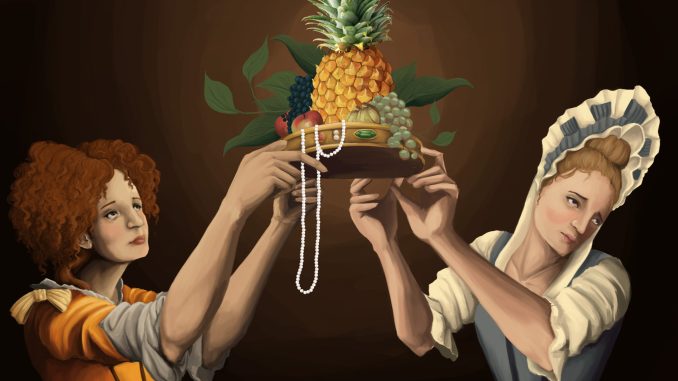
When you slice into a golden, juicy pineapple, you’re not just enjoying a tropical treat—you’re tasting centuries of history, exploration, and cultural symbolism. From indigenous farms in South America to royal banquets in Europe and sprawling plantations in Hawaii, the pineapple has played many roles throughout history. Let’s take a bite out of the pineapple’s fascinating story.
Roots in South America
Pineapples (scientific name Ananas comosus) originated in the tropical regions of South America, most likely in present-day Paraguay and southern Brazil. Indigenous peoples in these regions were the first to cultivate the pineapple. They prized the fruit not only for its sweet, refreshing flavor but also for its usefulness—pineapple leaves were used for weaving, and its juice for medicinal and ceremonial purposes.
From South America, the pineapple spread northward through trade and migration, eventually reaching the Caribbean and Central America. By the time Christopher Columbus arrived in the New World in 1493, he encountered the fruit on the island of Guadeloupe. He brought it back to Europe, and the pineapple’s second life began.
Europe’s Exotic Obsession
In 16th-century Europe, pineapples became an instant symbol of wealth and prestige. The fruit’s unique appearance—spiky crown, golden flesh—and its rarity made it a must-have at aristocratic gatherings. However, pineapples didn’t travel well, and growing them in Europe’s climate was a challenge. Elaborate glasshouses known as “pineries” were built to grow pineapples in places like England and the Netherlands, requiring years of cultivation and high costs.
Owning or displaying a pineapple became a status symbol. In fact, pineapples were so prized in 18th-century England that they were rented out for parties to impress guests—never eaten, just admired.
Symbol of Hospitality
Over time, the pineapple became a universal symbol of hospitality. This symbolism grew in colonial America, where hosts would display pineapples as centerpieces to show warmth and generosity. Today, you’ll still see pineapple motifs in architecture, decor, and signage across the American South and the Caribbean.
While there is no definitive reason for the exotic fruit featuring on the trophy, there are plenty of theories. One idea is that pineapples were a status symbol in the 19th century because they were mainly restricted to the upper classes. Source

Global Farming and the Rise of Plantations
In the 19th and 20th centuries, pineapple production moved to a global scale. Thanks to improved shipping methods and the development of canning, pineapples became more accessible. The fruit thrived in tropical climates, and large plantations were established in Hawaii, the Philippines, and parts of Africa.
The Eastern Cape is the biggest pineapple-producing region in South Africa.
Yielding approximately 80 000 tons per annum, more than 90 per cent of the crop is exported, while the remainder is enjoyed locally.
The Sunshine Coast towns of Port Alfred, Bathurst and East London provide the ideal warm and frost-free conditions to bring the pines to perfect ripeness and very little rain is required. The Cayenne is the most popular variety as its succulent, golden flesh is just right for juicing. Historically, the delicious tropical fruit was first planted in the region in the late 1800s and the Eastern Cape today competes with growers in Thailand and Indonesia. Source
One of the most influential figures in pineapple farming was James Dole, an American entrepreneur who established the Hawaiian Pineapple Company in 1901. Dole’s innovations in farming, packaging, and marketing turned pineapples into a household staple, especially in the United States.
While Dole and other companies made pineapple more available to the world, large-scale farming also brought challenges: labor exploitation, monoculture farming, and environmental concerns. Today, ethical sourcing and sustainable practices are growing priorities in the industry.
 Summerpride is South Africa’s largest pineapple processor.
Summerpride is South Africa’s largest pineapple processor.
We convert our fruit into Pineapple Juice Concentrate for local and international beverage producers. We offer top quality service and product to the market by controlling our value chain from the pineapple farms all the way through to the consumer. SummerPride
Pineapples Today: Culture Meets Cuisine
Modern pineapples are enjoyed worldwide, from tropical drinks to grilled dishes and desserts. In many cultures, the fruit remains tied to themes of welcome, celebration, and abundance. Beyond food, it continues to pop up in fashion, design, and pop culture—proof that the pineapple’s cultural appeal endures.
Final Thoughts
From sacred indigenous fruit to European status symbol to global commodity, the pineapple has journeyed far and wide. Its history reflects a complex blend of agriculture, trade, and culture—sweet and spiky, just like the fruit itself. So the next time you enjoy a slice, take a moment to savor the story behind it.


Leave a Reply